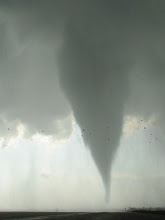Using the term "forecast" loosely, as I'm at the end of a mid shift and just coherent enough to throw together a discussion...
The first potential severe weather maker in the Plains in the past several weeks (aside from the bird fart of an event on March 9) is pretty clearly going to arrive on Monday. While many local and even national media outlets have, oddly, been advertising the potential for a considerable tornado outbreak, I remain unimpressed at worst and "mildly interested" at best w.r.t. tornado potential.
A large upper level trough, with 500 mb temps of -36 to -40°C, is currently over portions of the northern Pacific and Gulf of Alaska... with two embedded closed lows apparent off the coast of British Columbia and a third fast-moving perturbation ejecting into the forward side of the large scale trough. Digging mid- and high-level jets on the trough's back side will continue to carve out the trough as it consolidates southeastward into much of CA and the CA coastal waters Sunday night... and then turns east toward the central plains on Monday. The ECMWF and GFS are coming into very close agreement on mass fields with the 00Z run of each model. Expect a mid-level low to close off over eastern CO by 12Z Monday within the neutral tilt rough, and then lift northeast into western NE by 00Z... with an occluding, sub 990 mb surface low preceding it. The synoptic cold front will begin plunging through western NE and into northwestern KS during the day, probably forming a triple point with the occluding dryline in southcentral NE and far northcentral KS by afternoon.
A plethora of questions exist as they relate to the ultimate magnitude and type of severe weather. They include:
- Moisture/instability: although 65-72°F surface dewpoints are still hanging on essentially across the southwestern half of the Gulf of Mexico, the moisture is likely very shallow. Moreover, the sprawling surface ridge over much of the eastern seaboard and deep South will not budge a lot the next 48 hours, which means easterly trajectories persisting across the Gulf of Mexico... and with warm boundary layer air over the same areas, considerable moisture flux from the gulf would seem unlikely. Trajectories won't become more favorable for northwestward advection of higher moisture until sometime Sunday night. The GFS/ECMWF/NAM all agree on 100 mb ML dewpoints of 54-56°F spreading into central KS and central OK in advance of the dryline by Monday afternoon... which considering the above, looks reasonable. This is pretty poor moisture quality for a "warm sector" event in late March. The GFS generates/advects some very cold air atop the BL by 00Z (resulting in wickedly large low-level CAPE), which reeks of convective feedback. Also, the GFS keeps the warm sector socked in with low clouds and cool surface temps. Preferring the ECMWF/NAM thermodynamics, would expect at least filtered March sun ahead of the dryline to allow temperatures to climb to near 70°F. Although the impressively cold upper tropospheric air will lag well to the west, 0-2°C at 700mb overtaking the dryline by mid-afternoon should aid in eliminating the cap, with MLCAPE approaching 1000 J/kg and modest amounts of low-level CAPE.
- Storm mode / tornado threat: A strongly convergent dryline should evolve by mid-afternoon given the strength of the low-level cyclone and intense downward mixing of westerly momentum in the high plains. This coupled with strong DCVA on the inside of the mid-level jet max would seem to point toward fairly vigorous/widespread convective initiation in a narrow band from north to south. 0-6 km bulk shear vectors on the ECMWF have consistently shown a healthy crossover with the dryline (45-60 degrees), while on the 00Z GFS the angle is a bit smaller (though still respectable). Generally expect a mix of line segments and discrete cells given the favorable shear vector orientation coupled with very strong synoptic scale/mesoscale lift and modest instability. Given the ambient surface winds will probably be quite strong (25 kts or more), the 50-60 kt LLJ maintained by the ECMWF/NAM would be preferred in order to maintain strong low-level shear for a substantial tornado threat. The 00Z GFS hodographs looked a bit poorer than in previous runs with the primary LLJ core shifting east away from the dryline, though the 06Z run looks better again. Most of my experiences with very strong ambient surface winds have been bad ones as they are notorious for putting a big kabosh on low-level shear... but given a 50-60 kt LLJ is maintained during the afternoon and storms are successful in becoming rightward-deviant, that won't be an issue on Monday. We'll see.
As usual, mesoscale details should be clearer by the morning of the event. My biggest hope is that KC can get some more rainfall out of this one...
Saturday, March 21, 2009
Subscribe to:
Post Comments (Atom)

No comments:
Post a Comment